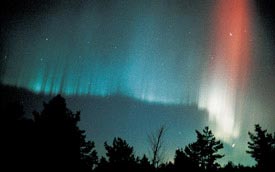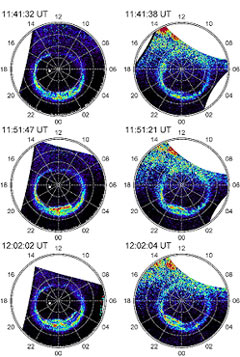
An aurora over Finland. Different colors formed at different altitudes, from 400 kilometers (where oxygen atoms glow green) to 1,000 km (where ionized nitrogen molecules glow blue and oxygen atoms red).
Courtesy Pekka Parviainen.
If you've ever read much about auroras, you probably learned that the Northern and Southern Lights ringing Earth's magnetic poles are always mirror images of each other. Well, it ain't necessarily so.
Scientists using NASA's POLAR and IMAGE spacecraft have managed to view the entire northern and southern "auroral ovals" simultaneously for the first time. While the two rings of light in the uppermost atmosphere were similar, they didn't stay exactly alike.

The 'auroral ovals' are semipermanent rings of light around the Earth's north (left) and south (right) magnetic poles. Contrary to what Earth scientists thought, they're not always exactly alike, as these near-simultaneous pairs show. The grid lines are centered on Earth's magnetic poles; white dots indicate the geographic poles. The Sunward direction is up, and Earth's dawn side is at right.
Courtesy NASA.
Timothy J. Stubbs (NASA/Goddard Space Flight Center) and his colleagues observed that, in particular, one or both ovals bent toward the dawn side of the planet, apparently due to the tilt of Earth's magnetic axis with respect to the magnetic field in the oncoming solar wind. In addition, one pole apparently captured more charged particles from the solar wind than the other, again due to the tilt of the axis. Moreover, irregularities in Earth's own field seem to distort the two auroral ovals separately. "Earth's magnetic field is not a perfect dipole," comments Stubbs in a NASA press release; "we think this fact plays some role in causing the auroras not to be mirror images of each other." For more information and animations see NASA's press release.
 0
0
Comments
You must be logged in to post a comment.